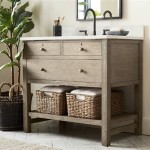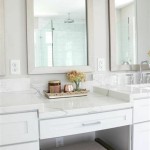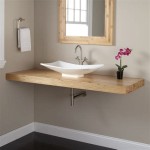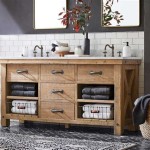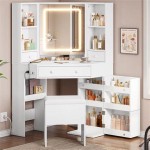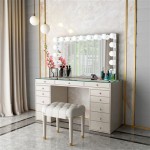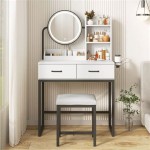Single Sink Freestanding Bath Vanity: A Comprehensive Guide
The single sink freestanding bath vanity is a popular choice for bathroom renovations and new constructions alike. It offers a combination of functionality, style, and ease of installation, making it a versatile option for a wide range of bathroom layouts and design preferences. This article provides a detailed examination of single sink freestanding bath vanities, covering their benefits, design considerations, material options, installation procedures, and maintenance tips.
A freestanding bath vanity, as the name suggests, stands independently on the floor. Unlike wall-mounted or built-in vanities, it does not require attachment to the wall for support, although it is typically secured to the wall for stability. This characteristic offers flexibility in placement and simplifies the installation process in many cases. The "single sink" designation indicates that the vanity is designed to accommodate one sink basin, optimizing space efficiency for smaller or medium-sized bathrooms.
Benefits of Choosing a Single Sink Freestanding Bath Vanity
Several advantages contribute to the popularity of single sink freestanding bath vanities. Their ease of installation, design versatility, storage capacity, and aesthetic appeal make them a desirable choice for many homeowners.
Ease of Installation: Freestanding vanities are generally easier to install than other types of vanities. Because they stand independently, the installation process typically involves minimal structural modifications. The primary tasks usually involve connecting the plumbing to the sink and securing the vanity to the wall for added stability. This simplified installation can save time and reduce labor costs, making it an attractive option for DIY enthusiasts or those seeking to minimize renovation expenses.
Design Versatility: Single sink freestanding vanities are available in a vast array of styles, finishes, and sizes. This extensive selection allows homeowners to find a vanity that seamlessly integrates with their existing bathroom décor. From traditional to contemporary designs, there are options to suit virtually any aesthetic preference. The variety of available materials, such as wood, metal, and manufactured composites, further expands the design possibilities. The size options range from compact models suitable for small powder rooms to larger units that provide ample countertop and storage space.
Storage Capacity: Most single sink freestanding vanities incorporate storage solutions, such as drawers, cabinets, and open shelving. These features provide valuable space for storing bathroom essentials, including toiletries, towels, and cleaning supplies. The configuration of the storage compartments can vary depending on the design of the vanity. Some models feature a combination of drawers and cabinets, while others offer adjustable shelves or pull-out organizers. The availability of ample storage helps to keep the bathroom organized and clutter-free.
Aesthetic Appeal: A well-chosen freestanding vanity can significantly enhance the overall aesthetic of a bathroom. The design of the vanity can serve as a focal point, adding character and style to the space. The variety of available finishes, such as painted, stained, or distressed wood, allows homeowners to create a desired ambiance. The choice of countertop material and sink style further contributes to the overall visual impact. A carefully selected vanity can transform a functional space into a stylish and inviting retreat.
Key Design Considerations
Before selecting a single sink freestanding bath vanity, it is crucial to consider several key design aspects to ensure that the chosen vanity meets the homeowner's specific needs and preferences. These considerations include size and space, style and finish, countertop material, and sink type.
Size and Space: The size of the vanity should be carefully considered in relation to the overall dimensions of the bathroom. It is important to ensure that the vanity fits comfortably within the available space and allows for easy movement around the bathroom. Measure the available space accurately and take into account the location of plumbing fixtures and other bathroom elements. When selecting a vanity size, also consider the amount of storage space required. Larger vanities typically offer more storage capacity, but may not be suitable for smaller bathrooms. Ensure adequate clearance for opening drawers and cabinet doors.
Style and Finish: The style and finish of the vanity should complement the existing décor of the bathroom. Consider the overall aesthetic of the bathroom and choose a vanity that aligns with that style. For example, a traditional bathroom might benefit from a vanity with a classic design and a rich wood finish, while a contemporary bathroom might be better suited to a vanity with clean lines and a sleek, minimalist design. The finish of the vanity should also be durable and resistant to moisture damage. Popular finish options include painted, stained, and distressed wood, as well as metal and composite materials. Consider the ease of cleaning and maintenance when choosing a finish.
Countertop Material: The countertop material is a critical consideration, as it affects both the appearance and durability of the vanity. Common countertop materials include granite, marble, quartz, solid surface, and laminate. Each material has its own unique characteristics, advantages, and disadvantages. Granite and marble are natural stone materials that offer a luxurious look and feel, but they require regular sealing to prevent staining. Quartz is a manufactured stone that is durable, stain-resistant, and relatively low-maintenance. Solid surface materials are non-porous and seamless, making them easy to clean and resistant to bacteria growth. Laminate is a cost-effective option that is available in a wide range of colors and patterns, but it is less durable than other materials.
Sink Type: The type of sink that is used with the vanity can also impact the overall design and functionality of the bathroom. Common sink types include undermount, vessel, and drop-in sinks. Undermount sinks are installed beneath the countertop, creating a seamless and easy-to-clean surface. Vessel sinks sit on top of the countertop, adding a decorative element to the vanity. Drop-in sinks are installed into a pre-cut hole in the countertop, offering a balance of functionality and aesthetics. The choice of sink type should be based on personal preference and the overall design of the bathroom.
Material Options for Single Sink Freestanding Bath Vanities
The materials used in the construction of a single sink freestanding bath vanity significantly impact its durability, appearance, and cost. Common materials include wood, metal, and manufactured composites, each offering distinct properties and aesthetic qualities.
Wood: Wood is a classic and versatile material that is widely used in the construction of bath vanities. It offers a warm and natural look, and can be stained or painted to match a variety of design styles. Solid wood vanities are durable and long-lasting, but they can be more expensive than vanities made from other materials. Plywood and MDF (Medium-Density Fiberboard) are also commonly used in vanity construction. Plywood is a strong and stable material that is resistant to warping, while MDF is a smooth and consistent material that is ideal for painting. However, both plywood and MDF are susceptible to water damage if not properly sealed. When choosing a wood vanity, it is important to ensure that it is properly sealed and finished to protect it from moisture.
Metal: Metal vanities offer a sleek and contemporary look. Stainless steel is a popular choice for its durability, corrosion resistance, and clean aesthetic. Metal vanities are often used in modern or industrial-style bathrooms. They are typically easy to clean and maintain, but can be more expensive than wood vanities. The finish on a metal vanity should be durable and resistant to scratches and dents.
Manufactured Composites: Manufactured composites, such as PVC (Polyvinyl Chloride) and particleboard with laminate, offer a cost-effective alternative to wood and metal. These materials are typically water-resistant and easy to clean, making them suitable for use in bathrooms. PVC vanities are often used in high-moisture environments, as they are resistant to mold and mildew growth. Particleboard with laminate is a more affordable option, but it is less durable than other materials. The laminate finish can be susceptible to peeling or chipping if exposed to excessive moisture or impact.
The choice of material should be based on a combination of factors, including budget, desired aesthetic, and durability requirements. Consider the environmental conditions in the bathroom and choose a material that is resistant to moisture damage. It is also important to choose a material that is easy to clean and maintain.
Proper maintenance is essential for extending the lifespan of a single sink freestanding bath vanity. Regular cleaning with a mild soap and water solution can help to prevent the buildup of dirt and grime. Avoid using abrasive cleaners or harsh chemicals, as they can damage the finish of the vanity. Check for leaks regularly and repair them promptly to prevent water damage. Apply a sealant to the countertop as needed to protect it from staining. By following these maintenance tips, homeowners can ensure that their single sink freestanding bath vanity remains in good condition for years to come.

Staykiwi 30 In W X 18 D 34 80 H Single Sink Freestanding Bath Vanity White With Ceramic Top Skby2bv05 30w The Home

60 Single Sink Freestanding Bathroom Vanity With Engineered Marble To Homebeyond

Flow Floor Mount 20 Single Sink Vanity Freestanding Bathroom Vanities Toronto Canada Virta Luxury Furniture

Glam Freestanding Bathroom Sink Vanity Single Set Clearhalo

Altair Bondi 24 In W Single Sink Freestanding Bath Vanity Light Brown With White Ceramic Top 572024 Lb Wh Nm The Home

60 Single Sink Freestanding Bathroom Vanity With Engineered Marble To Homebeyond

Bliss 60 Single Sink Freestanding Modern Bathroom Vanity

Eisen Home Eh Broadway 36 W 1 4 Inch Single Sink Freestanding Bathroom Vanity Set Flat White Kitchen

Manhattan 36 Single Sink Freestanding Bathroom Vanity White Cutler Kitchen Bath

Everdean 48 In W X 19 D 34 H Single Sink Freestanding Bath Vanity White With Cultured Marble Top 3d Decorative

